An RTDS-Based Testbed for Investigating the Impacts of Transmission-Level Disturbances on Solar PV Operation
Abstract
:1. Introduction
- On 16 August 2016, the transmission system owned by Southern California Edison experienced thirteen 500 kV line faults, and the system owned by the Los Angeles Department of Water and Power experienced two 287 kV faults as a result of the fire. The most significant event resulted in the loss of nearly 1200 MW. There were no solar PV facilities de-energized as a direct consequence of the fault event; rather, the facilities ceased output as a response to the fault on the system [1].
- On 9 October 2017, the fire caused two transmission system faults near the Serrano substation, east of Los Angeles. The first fault was a normally cleared phase-to-phase fault on a 220 kV transmission line, and the second fault was a normally cleared phase-to-phase fault on a 500 kV transmission line. Both faults resulted in approximately 900 MW of solar PV generation loss [2].
- On 20 April 2018 and 11 May 2018, two similar events caused a loss of solar photovoltaic (PV) facilities in response to transmission line faults, though no generating resources were tripped as a consequence of either of the line outages [3].
- On 7 July 2020, the static wire on a 230 kV double circuit tower failed, causing a single-line-to-ground fault on both the #1 and #2 parallel circuits on the tower. The fault was cleared normally in about three cycles. In addition, a nearby 230 kV line relay incorrectly operated for an external fault. For this first fault event, approximately 205 MW of power reduction was observed at solar PV facilities in the Southern California region. After the #1 circuit was re-energized and held, the #2 line was re-energized and relayed back out due to a low-impedance three-phase fault that was cleared normally in 2.3 cycles. This second fault event experienced a larger 1000 MW reduction in solar PV output primarily due to the fact that it was a three-phase fault [4].
- (1)
- To generate realistic transmission-level disturbances and investigate their impacts on solar PVs in distribution systems, a real-time electromagnetic simulation testbed is constructed based on RTDS, which is developed by RTDS Technologies Inc. to solve the power system equations fast enough to realistically represent conditions in actual power grids [16].
- (2)
- The testbed has a full model of a transmission system, distribution system, and solar PVs. In the modeling of solar PVs, the detailed PV inverter controls are considered in the distribution system with the comprehensive models of synchronous machines and excitation in the transmission system.
- (3)
- By using this testbed to investigate the impact of the transmission-level disturbances on solar PV operation under different fault types and locations, solar penetration levels, and loading levels, it is found that the grid strength at different POIs significantly affects the transient stability of solar PV operation. Particularly, at the weak POIs, undesirable transient stability events are more likely to occur under increasing solar penetration levels or decreasing loading levels following severe transmission-level disturbances.
2. RTDS-Based Testbed
2.1. RTDS
2.2. RTDS-Based Representative Power System Model
2.2.1. Transmission System
- The synchronous generator and its excitation and governor systems are represented by a hierarchy component box. As shown in Figure 3a, this hierarchy component box includes the models of a synchronous machine and its excitation and governor systems. All the synchronous machine systems are modeled with a steam turbine, a governor system and an excitation system. The excitation system is modeled with an AC excitation type (EXAC1A) model. The time constants, regulators, and feedback gains are the input parameters for the excitation system. The machine is connected to the transmission system via a transformer.
- The transmission lines in the system are represented by the unified T-line model. As shown in Figure 3b, the unified T-line model is composed of three electrical components: sending end, terminal end, and calculation box. The unified T-line model can be used for a Bergeron or a frequency-dependent phase model, but when required, either of these models can be collapsed into a simpler PI representation of a line. It is noted that in [9], the data are compensated for long line effects. The transmission lines in the RTDS simulation case are modeled using the Bergeron line model, which is simulated using distributed line parameters. Thus, the long line compensation was removed [15] to obtain the uncompensated data for the developed model.
- The load is represented by a dynamic load component in the transmission side of the network, which is shown in Figure 3c. The load model can be used to dynamically adjust the load to maintain real power and reactive power set points using variable conductance. Additionally, this model allows setting up the initial values and limits of real and reactive power absorbed by a load.
2.2.2. Distribution System
- In this system, a delta-wye transformer is connected to the transmission system, and it is represented by a two-winding, three-phase transformer model, which is shown in Figure 4a.
- The distribution line is represented by the PI section model in which a set of PI sections are connected in series, as shown in Figure 4b. It is noted that the PI section model requests the capacitance from the wire to the ground. The data given in [19] are the shunt capacitance matrix. Thus, the capacitance from the wire to the ground needs to be calculated from this matrix.
- The load in the system is represented by hierarchy component boxes. As shown in Figure 4c, different colored hierarchy component boxes include different connections of loads, which are modeled by the dynamic load component.
2.2.3. Solar PV System
- A PV array model is used to represent the combination of individual solar cells into PV arrays to produce voltages and currents at the terminals of a PV array. The PV array generates power as a function of irradiation and temperature. The parameters of the PV array model can be modified to obtain a certain output power for the given irradiation and temperature. Each PV array has a temperature set to 25 °C and insolation to 1000 W/m2 as input. This model can specify the parameters about how the cells are connected to form arrays. Additionally, this model can select different methods for estimating the maximum power point for a given insolation and temperature. The detailed parameters of the PV array are presented in Table 1.
- The AVM component models the averaged converter control dynamics developed by equivalent voltage and current sources. As shown in Figure 7, solar PV controls use the maximum power point tracking (MPPT) algorithm, which computes the DC voltage set point required for maximum power transfer based on the temperature and insolation levels of the PV array. This DC voltage set point then feeds into the outer loop DC-bus voltage control, which computes a corresponding real power set point. The real and reactive power is then fed into the inner current control loop operating in the dq reference frame and a set of three-phase modulation waveforms is synthesized. These modulation waveforms are then used in a carrier-based, sinusoidal pulse width modulation (SPWM) strategy to generate a corresponding set of firing pulses.
3. Impact Analysis of Transmission-Level Disturbances on Distributed Solar PV Operation
3.1. Impact of Fault Types in Transmission System on Solar PV Operation
3.2. Impact of Fault Locations in the Transmission System on Solar PV Operation
3.3. Impact of Solar Penetration Levels on Solar PV Operation under Transmission-Level Faults
3.4. Impact of Loading Levels on Solar PV Operation under Transmission-Level Faults
3.5. Impact of Grid Strength on Solar PV Operation under Transmission-Level Faults with Different Solar Penetration Levels and Loading Levels
4. Discussions
5. Conclusions
Author Contributions
Funding
Institutional Review Board Statement
Informed Consent Statement
Data Availability Statement
Conflicts of Interest
References
- North American Electric Reliability Corporation. 1200 MW Fault Induced Solar Photovoltaic Resource Interruption Disturbance Report; North American Electric Reliability Corporation: Atlanta, GA, USA, 2016. [Google Scholar]
- North American Electric Reliability Corporation. 900 MW Fault Induced Solar Photovoltaic Resource Interruption Disturbance Report; North American Electric Reliability Corporation: Atlanta, GA, USA, 2018. [Google Scholar]
- North American Electric Reliability Corporation. April and May 2018 Fault Induced Solar Photovoltaic Resource Interruption Disturbances Report: Southern California Events: 20 April 2018 and 11 May 2018; North American Electric Reliability Corporation: Atlanta, GA, USA, 2019. [Google Scholar]
- San Fernando Disturbance Southern California Event: 7 July 2020 Joint NERC and WECC Staff Report. Atlanta, GA, USA, 2020. Available online: https://www.nwpp.org/news/power-insights-podcast-episode-2-san-fernando-even (accessed on 25 June 2021).
- Kang, S.; Shin, H.; Jang, G.; Lee, B. Impact Analysis of Recovery Ramp Rate After Momentary Cessation in Inverter-based Distributed Generators on Power System Transient Stability. IET Gener. Transm. Distrib. 2020, 15, 24–33. [Google Scholar] [CrossRef]
- Pierre, B.J.; Elkhatib, M.E.; Hoke, A. Photovoltaic Inverter Momentary Cessation: Recovery Process is Key. In Proceedings of the 2019 IEEE 46th Photovoltaic Specialists Conference (PVSC), Chicago, IL, USA, 16–21 June 2019. [Google Scholar]
- Choi, N.; Park, B.; Cho, H.; Lee, B. Impact of Momentary Cessation Voltage Level in Inverter-Based Resources on Increasing the Short Circuit Current. Sustainability 2019, 11, 1153. [Google Scholar] [CrossRef] [Green Version]
- Zhu, S.; Piper, D.; Ramasubramanian, D.; Quint, R.; Isaacs, A.; Bauer, R. Modeling Inverter-Based Resources in Stability Studies. In Proceedings of the 2018 IEEE Power & Energy Society General Meeting (PESGM), Portland, OR, USA, 5–10 August 2018. [Google Scholar]
- Shin, H.; Jung, J.; Lee, B. Determining the Capacity Limit of Inverter-Based Distributed Generators in High-Generation Areas Considering Transient and Frequency Stability. IEEE Access 2020, 8, 34071–34079. [Google Scholar] [CrossRef]
- Mather, B.; Ding, F. Distribution-connected PV’s response to voltage sags at transmission-scale. In Proceedings of the 2016 IEEE 43rd Photovoltaic Specialists Conference (PVSC), Portland, OR, USA, 5–10 June 2016; pp. 2030–2035. [Google Scholar]
- Mather, B.; Aworo, O.; Bravo, R.; Piper, P.E.D. Laboratory Testing of a Utility-Scale PV Inverter’s Operational Response to Grid Disturbances. In Proceedings of the 2018 IEEE Power & Energy Society General Meeting (PESGM), Portland, OR, USA, 5–10 August 2018; pp. 1–5. [Google Scholar]
- Kenyon, R.W.; Mather, B.; Hodge, B.-M. Coupled Transmission and Distribution Simulations to Assess Distributed Generation Response to Power System Faults. Electr. Power Syst. Res. 2020, 189, 106746. [Google Scholar] [CrossRef]
- Shin, H.; Jung, J.; Oh, S.; Hur, K.; Iba, K.; Lee, B. Evaluating the Influence of Momentary Cessation Mode in Inverter-Based Distributed Generators on Power System Transient Stability. IEEE Trans. Power Syst. 2020, 35, 1618–1626. [Google Scholar] [CrossRef]
- Li, C.; Reinmuller, R. Fault Responses of Inverter-based Renewable Generation: On Fault Ride-Through and Momentary Cessation. In Proceedings of the 2018 IEEE Power & Energy Society General Meeting (PESGM), Portland, OR, USA, 5–10 August 2018. [Google Scholar]
- Pierre, B.J.; Elkhatib, M.E.; Hoke, A. PV Inverter Fault Response Including Momentary Cessation, Frequency-Watt, and Virtual Inertia. In Proceedings of the 2018 IEEE 7th World Conference on Photovoltaic Energy Conversion (WCPEC) (A Joint Conference of 45th IEEE PVSC, 28th PVSEC & 34th EU PVSEC), Waikoloa, HI, USA, 10–15 June 2018. [Google Scholar]
- RTDS Technologies Inc. Available online: https://www.rtds.com (accessed on 25 June 2021).
- Sauer, P.W.; Pai, M.A. Power System Dynamics And stability; Wiley Online Library: Hoboken, NJ, USA, 1998; Volume 101. [Google Scholar]
- Kersting, W.H. Distribution System Modeling and Analysis; CRC Press: Boca Raton, FL, USA, 2017. [Google Scholar]
- IEEE PES AMPS DSAS Test Feeder Working Group. Available online: https://site.ieee.org/pes-testfeeders/resources/ (accessed on 25 June 2021).
- Grainger, J.J.; Stevenson, W.D., Jr. Power System Analysis; McGrawHill: New York, NY, USA, 1994. [Google Scholar]
- Wu, D.; Li, G.; Javadi, M.; Malyscheff, A.M.; Hong, M.; Jiang, J.N. Assessing impact of renewable energy integration on system strength using site-dependent short circuit ratio. IEEE Trans. Sustain. Energy 2017, 9, 1072–1080. [Google Scholar] [CrossRef]




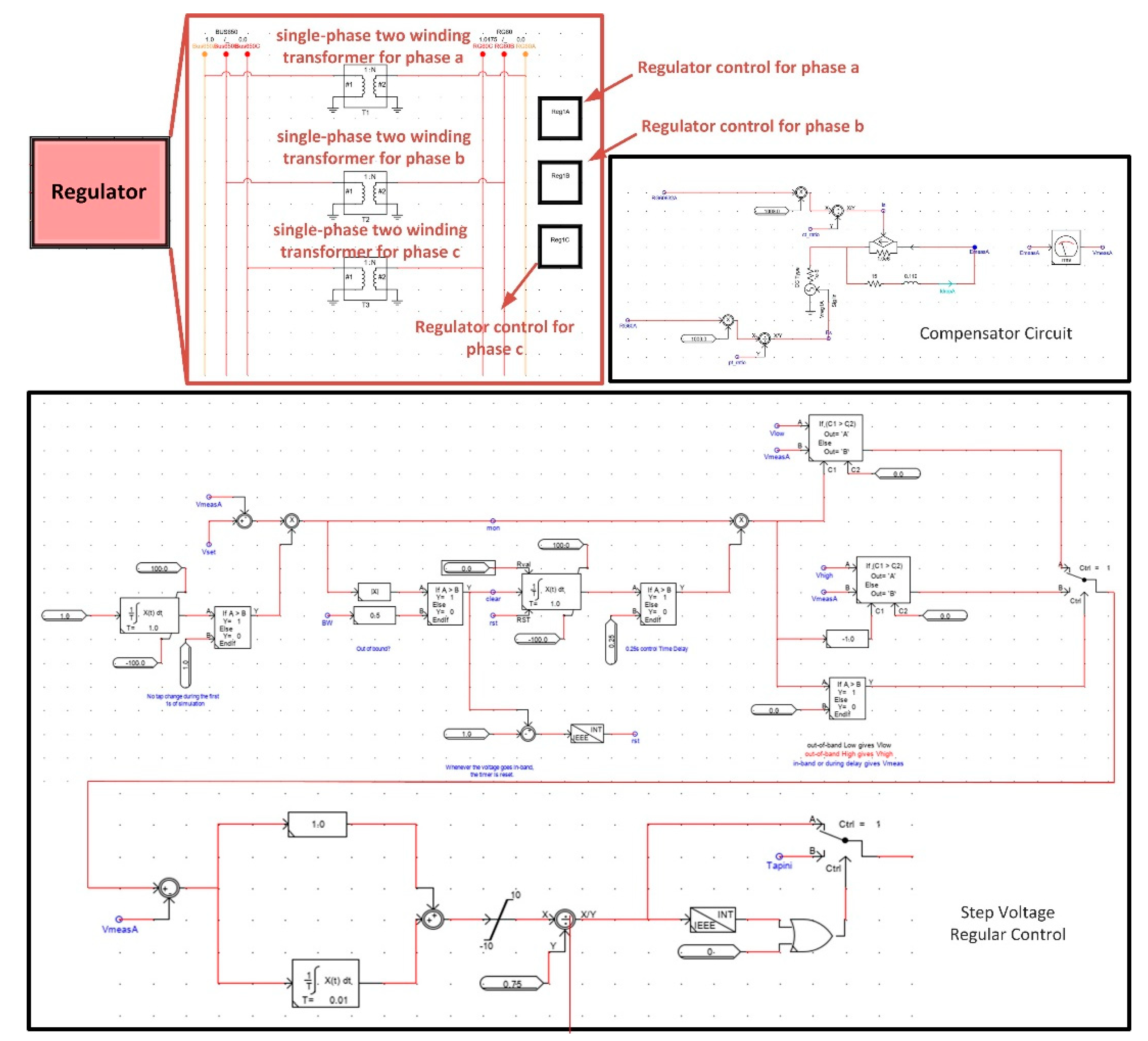



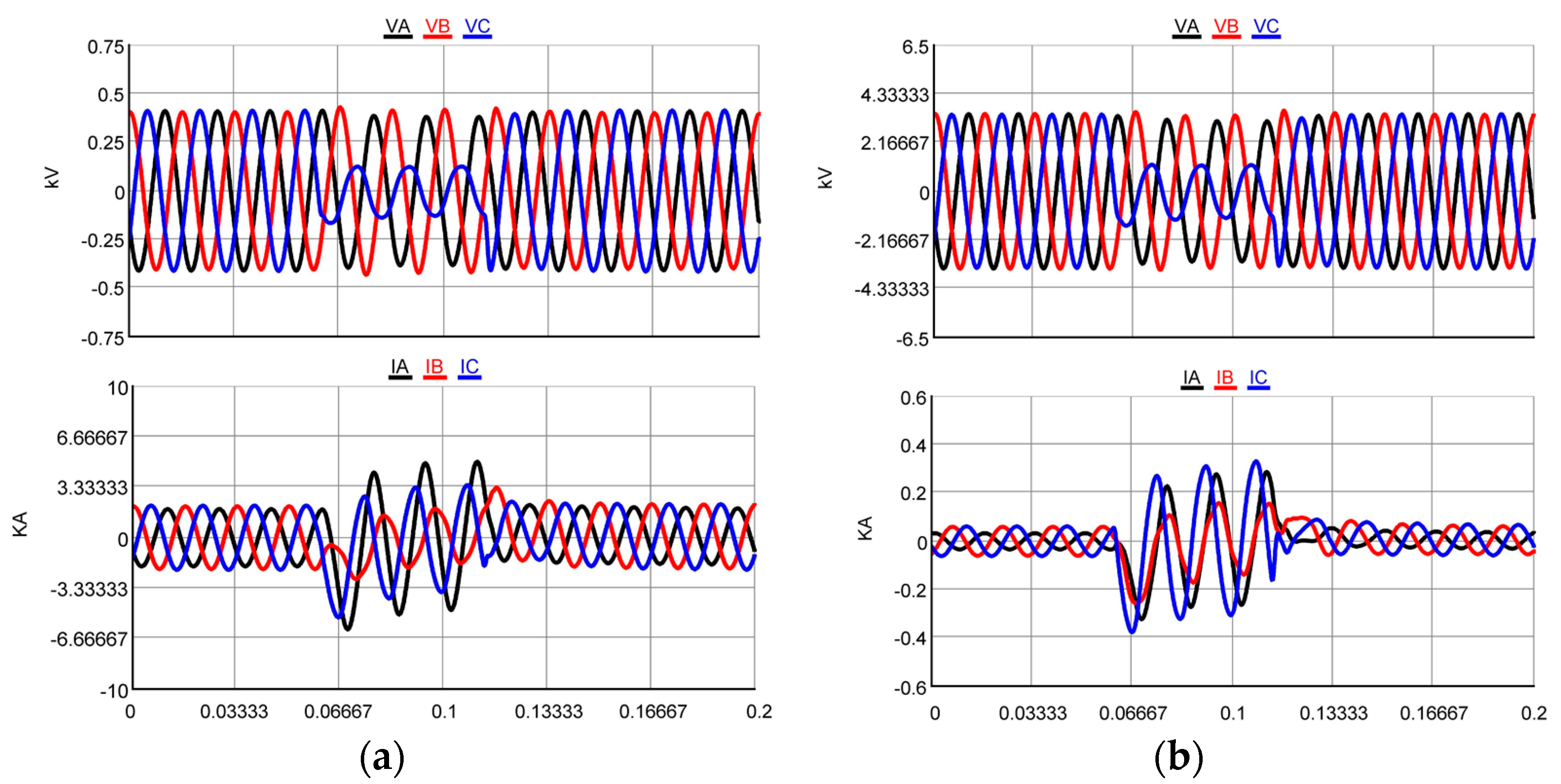
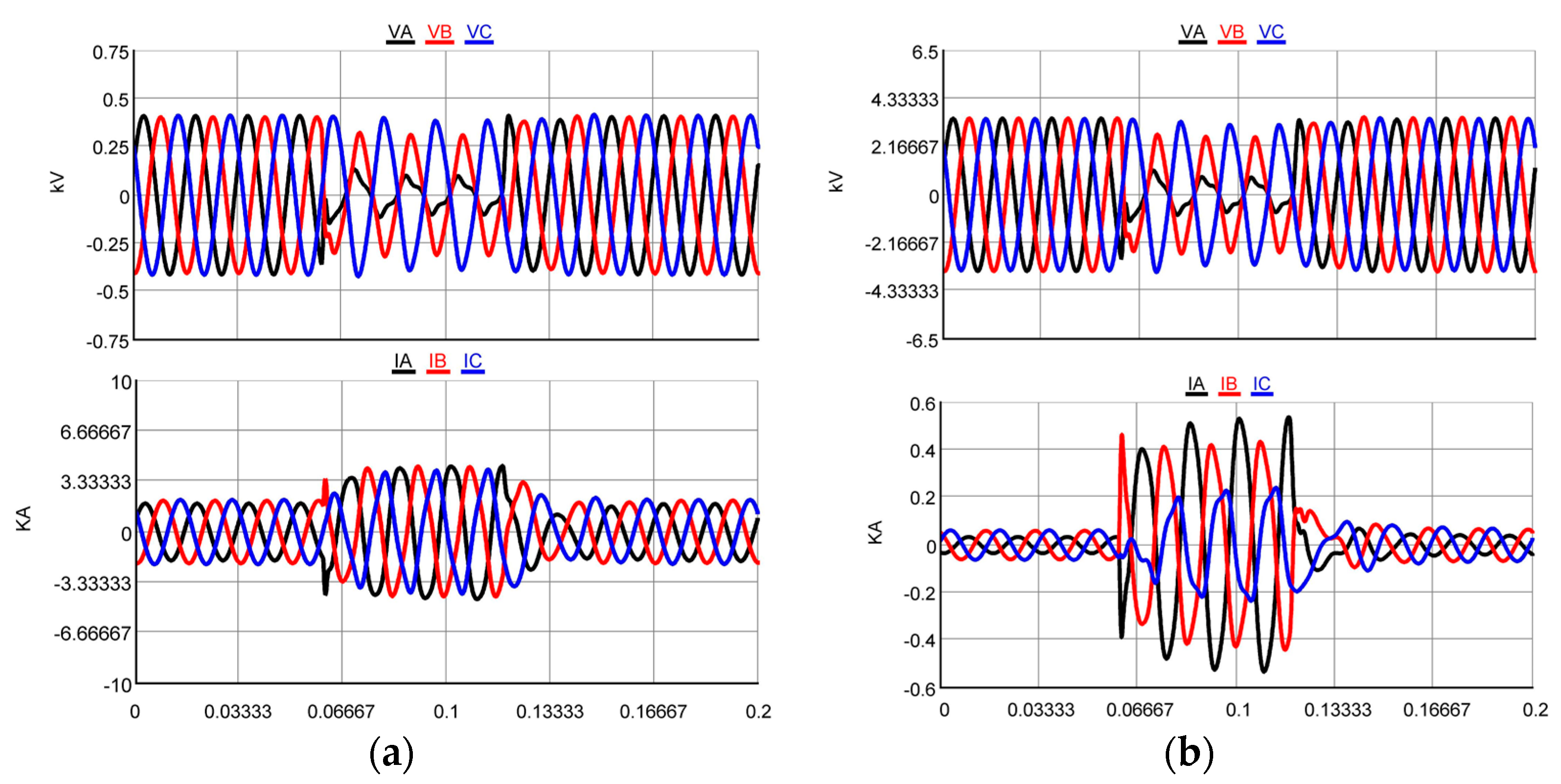
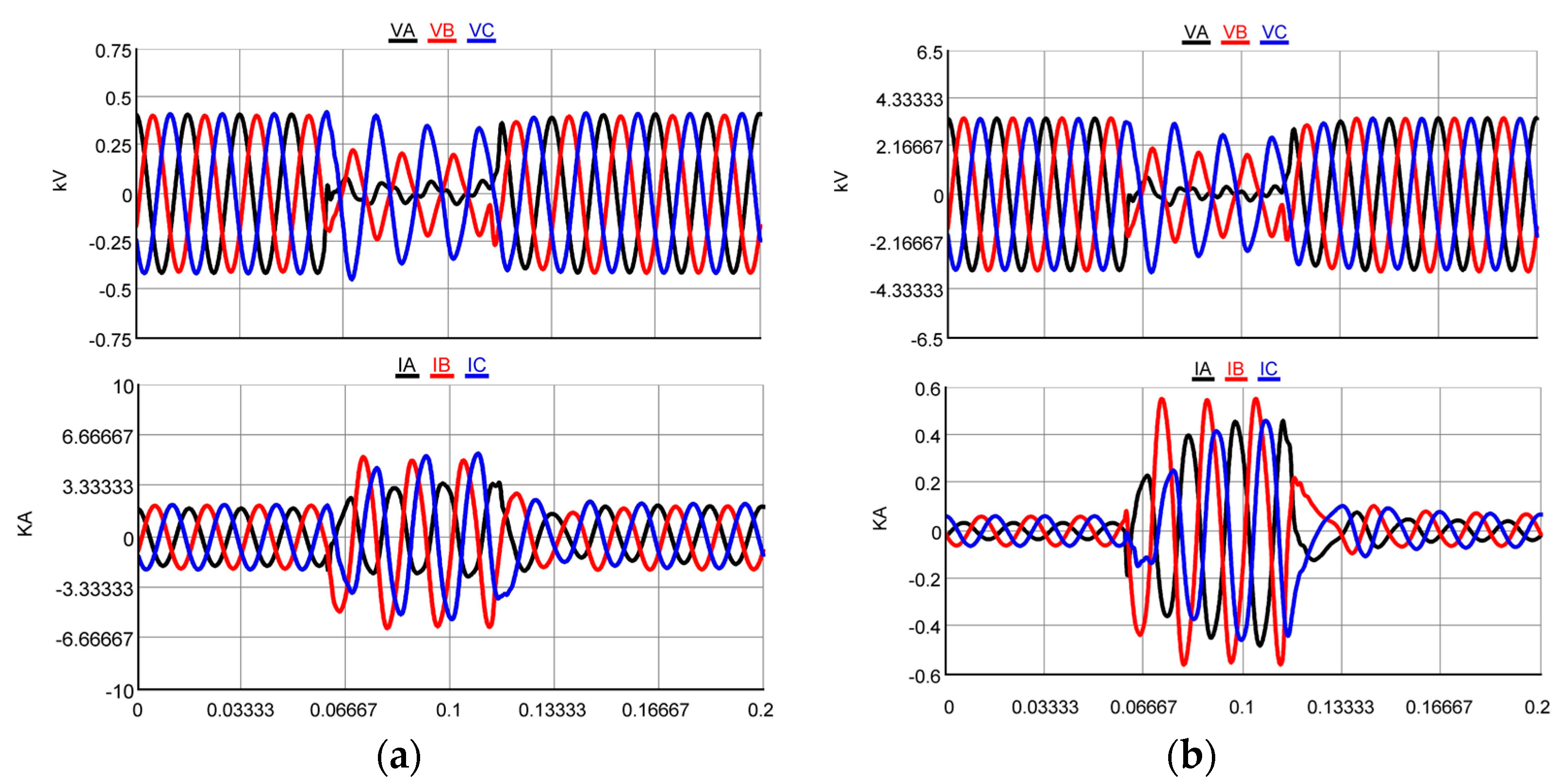
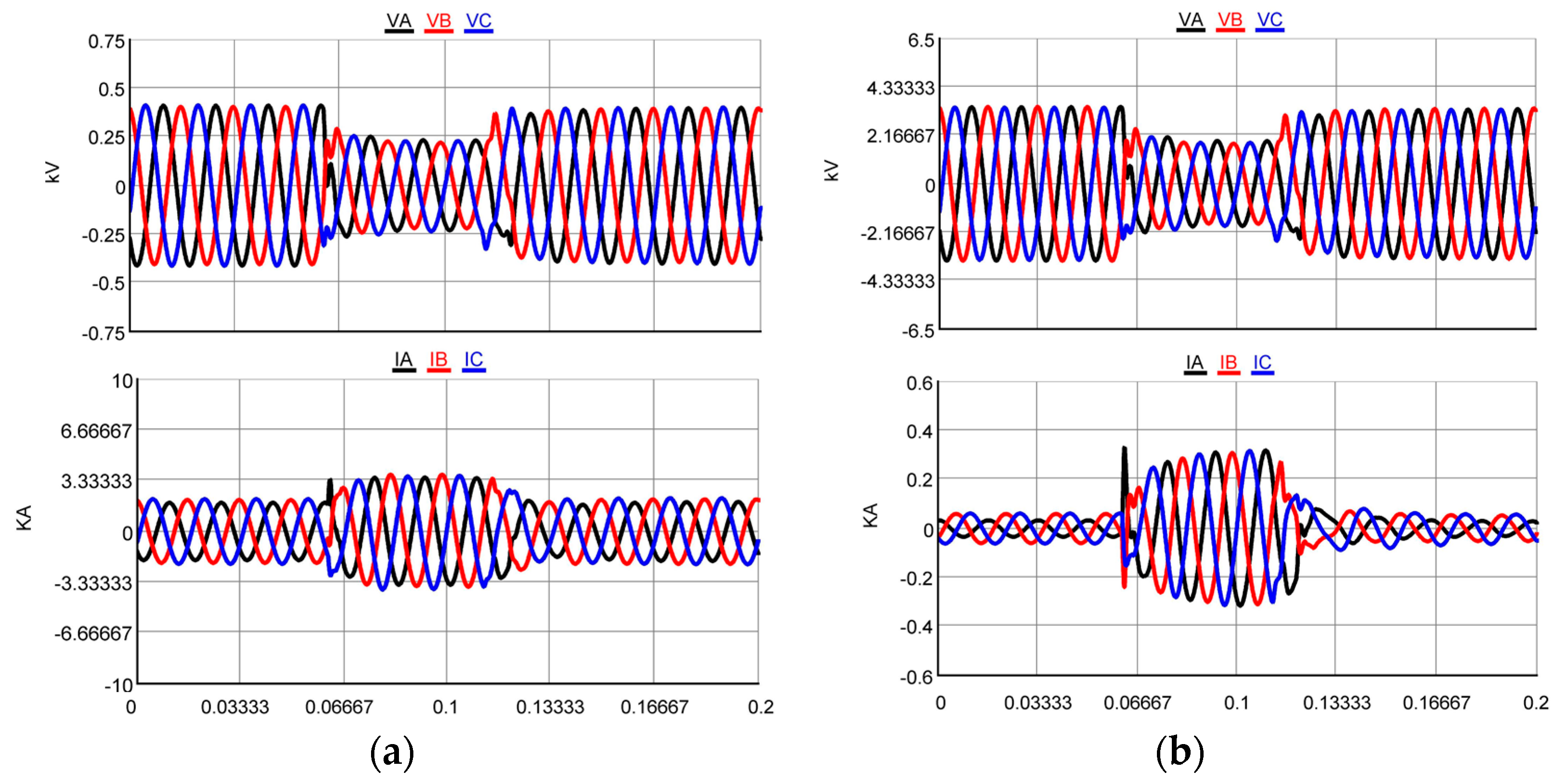

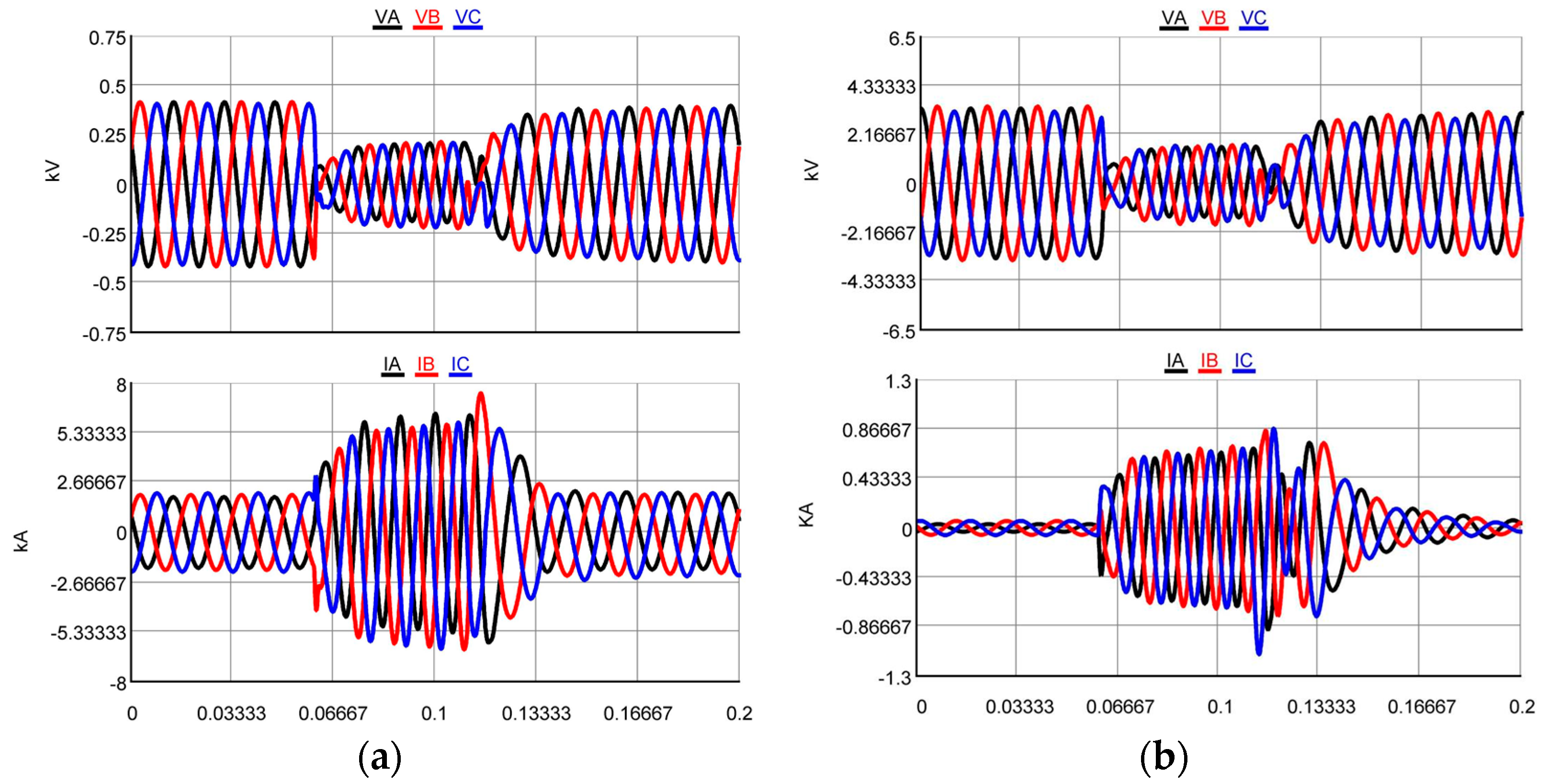
| Components | Parameters | Values |
|---|---|---|
| PV | Number of series cells | 36 |
| Number of parallel strings | 1 | |
| Open-circuit voltage (Voc) | 21.7 V | |
| Short-circuit current (Isc) | 3.35 A | |
| Number of modules in series | 115 | |
| Number of modules in parallel | 285 | |
| Voltage at Pmax | 17.4 V | |
| Current at Pmax | 3.05 A | |
| DC link capacitor | Capacitance (Cdc) | 5 mF |
| Inverter | Filter resistance | 1.0 mΩ |
| Filter inductance | 100 μH | |
| High-pass filter | RH | 0.039 Ω |
| LH | 7.874 μH | |
| CH | 2500 μF | |
| Current control loop | kpi | 0.2 |
| kii | 0.30675 | |
| PLL | kpPLL | 5 |
| kiPLL | 0.01 |
| Solar PV Buses | SDSCR Values |
|---|---|
| 632 | 3.6346 |
| 634 | 3.3830 |
| 671 | 2.7768 |
| 675 | 3.0545 |
| 680 | 2.4765 |
Publisher’s Note: MDPI stays neutral with regard to jurisdictional claims in published maps and institutional affiliations. |
© 2021 by the authors. Licensee MDPI, Basel, Switzerland. This article is an open access article distributed under the terms and conditions of the Creative Commons Attribution (CC BY) license (https://creativecommons.org/licenses/by/4.0/).
Share and Cite
Maharjan, M.; Ekic, A.; Strombeck, B.; Wu, D. An RTDS-Based Testbed for Investigating the Impacts of Transmission-Level Disturbances on Solar PV Operation. Energies 2021, 14, 3867. https://doi.org/10.3390/en14133867
Maharjan M, Ekic A, Strombeck B, Wu D. An RTDS-Based Testbed for Investigating the Impacts of Transmission-Level Disturbances on Solar PV Operation. Energies. 2021; 14(13):3867. https://doi.org/10.3390/en14133867
Chicago/Turabian StyleMaharjan, Manisha, Almir Ekic, Bennett Strombeck, and Di Wu. 2021. "An RTDS-Based Testbed for Investigating the Impacts of Transmission-Level Disturbances on Solar PV Operation" Energies 14, no. 13: 3867. https://doi.org/10.3390/en14133867
APA StyleMaharjan, M., Ekic, A., Strombeck, B., & Wu, D. (2021). An RTDS-Based Testbed for Investigating the Impacts of Transmission-Level Disturbances on Solar PV Operation. Energies, 14(13), 3867. https://doi.org/10.3390/en14133867





